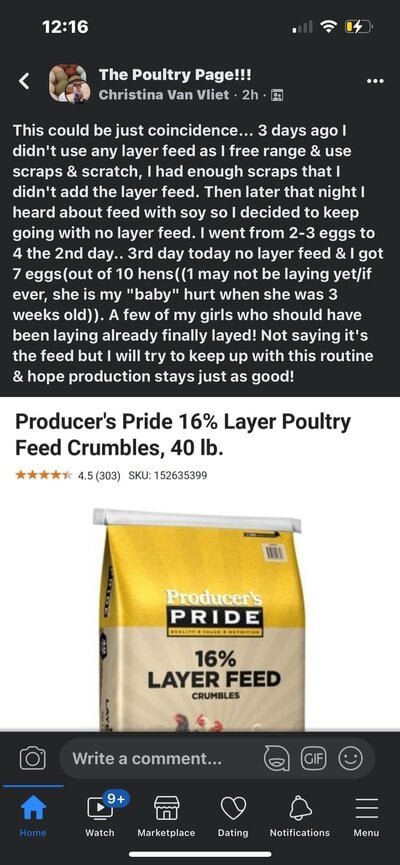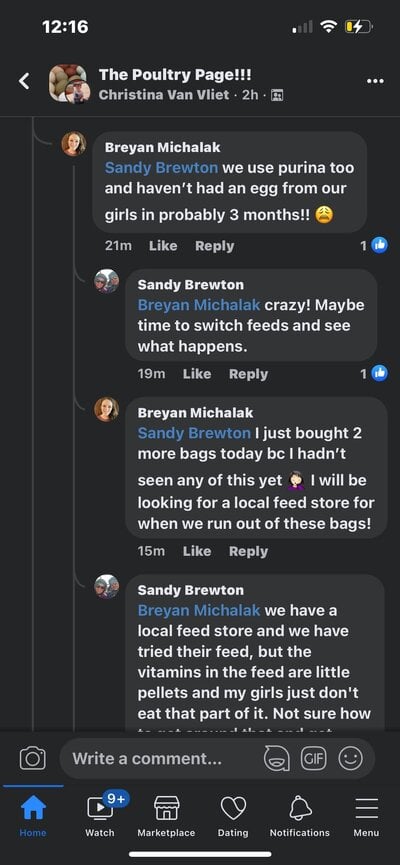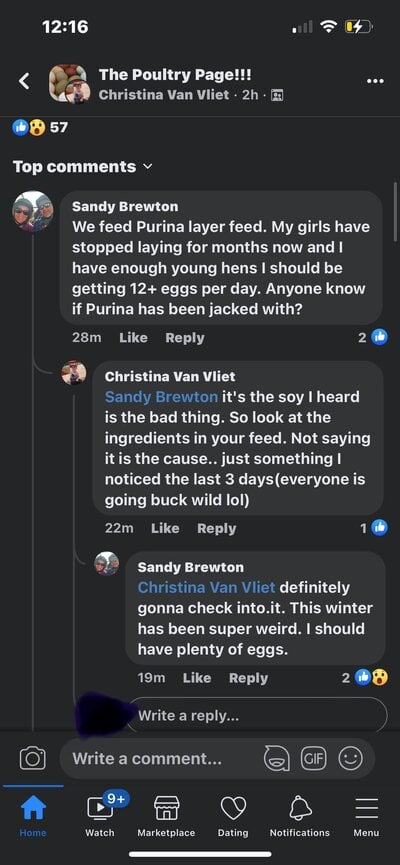So I have 15 laying hens, and 6 laying ducks and I feed Purina layena and I’ve been mixing in country spirit layer crumbles due to feed prices. But I’ve noticed, egg production has dropped from around 12-15 eggs a day, to about 2 duck eggs, and usually only 1-2 chicken eggs. There was a miracle yesterday and I got three chicken eggs. I had originally thought it was just because of winter, but now I’m beginning to think otherwise. Recently I’ve been hearing about feed being the reason for loss of egg production, and sone things about high soy content in chicken feed. I’ve also heard some rumors about deficiencies which can be “cured” by mixing in rice and pinto beans well cooked into feed if someone chooses to feed the brands which are deficient. I’m slightly skeptical about trying these things, and although I want to change feeds asap, I have just over 200 pounds of the old stuff. What are your thoughts on these events? What feed do you get? How many eggs are you getting each day? I have customers who rely on me for eggs and so I’m struggling with this. Any thoughts appreciated.
Navigation
Install the app
How to install the app on iOS
Follow along with the video below to see how to install our site as a web app on your home screen.
Note: This feature may not be available in some browsers.
More options
You are using an out of date browser. It may not display this or other websites correctly.
You should upgrade or use an alternative browser.
You should upgrade or use an alternative browser.
Feeds affecting laying?
- Thread starter picklestheduck
- Start date
- Status
- Not open for further replies.
U_Stormcrow
Crossing the Road
No, they don't actually.The rice and beans add protein and the two ingredients said to be now reduced in the TS/Purina feed. They are actually good for chickens.
On a side note, I no longer trust the ingredient list or percents since there is no trustworthy agency, ie one that cannot be paid off, to police the companies, esp companies whose owners and ceos have ties to WEF.
Rice has about half the minimal nutritional target for crude protein in a Layer formulation (which is intended to provide the lowest cost formulation for production layers under production managemetn, kept for production lifespans [until first adult molt], below which decreases in egg size, laying frequency and increased chicken mortality exceeds the projected savings in feed costs). Due in part to its low total protein, its deficient in each of the four key limiting amino acids. However, it is high in mKe as measured in MJ/Kg and makes a half decent substitute for corn in countries like Japan and China where rice is abundant, but corn is not.
Beans vary, and are relatively high in protein, yes, but need heat treatment (click on the "nutritional aspects" tab) to reduce anti-nutritional factors. Sadly, beans don't contain a complete protein, their AA profile is high in Lysine (that's good) and Threonine (that's good) and not bad in Tryptophan, but low in Methionine. That's a problem.
When vegan humans engage in protein complimentation, its a lot of rice, plus a little bit of beans, to result in not much of a more or less balanced complete protein. We "make up" for the limited total protein by eating larger quantities. With our mass, that's fine. With a 4.5# chicken? Its not. A chicken will hit its daily mKe needs long before it hits its Met needs eating two ingredients which average just 0.22 Met between them. To hit the old minimum target of 0.3%, they would need to increase consumption almost 50%.
Its obvious you are new to this. Your trust has been abused. Please, verify before repeating something you read somewhere. This is how ignorance is spread. Also, you won't find rice on a Purina feed label, unless its Purina One dog food, "Chicken & rice" flavor.
Last edited:
U_Stormcrow
Crossing the Road
Actually, we are comparing feed labels right here.I've only seen people in the US talk about this, and it always seems like they got their info from another video/youtuber/tiktoker and repeat. I haven't seen anyone compare feed labels or talk about nutrients or consider other stressors or the sunshine. If I'm wrong, let me know?
and plenty of us more experienced osters have talked about the effects of daylight hours, the freakish weather we've had of late further reducing effective daylight hours (and environmental stressors on chickens), the effects of hen age on both total rate of lay and tendency to "pause" (since so many have birds that laid thru their first winter, bought near start of pandemic, and are now experiencing their first adult molt) and exploring other factors (very old feeds from poor inventory management, something some TSC locations are famed for), increased aflatoxins from unusually wet periods near harvest, etc...
but for the few who have rejected all those alternative explanations, and also won't trust a feed label (but won't send it for testing, either)? They have created an unfalsifiable narrative by rejecting all contrary evidence to reinforce their prexisting world view, reality be damned. ...I can't cure stupid, all I can do is try to help fix ignorance.
My 15 hens went from 4-6 a day eggs last week to 9 eggs a day this week. Sorry I don't feed those feeds & haven't changed anything. It's the increase in daylight & it happens every year.
CarlaCo
Songster
The rice and beans add protein and the two ingredients said to be now reduced in the TS/Purina feed. They are actually good for chickens.Ok great thank you. Yeah I wasn’t so sure how I felt about the rice and beans, and last I heard it had mostly been something someone suggested and no one had confirmed results.
On a side note, I no longer trust the ingredient list or percents since there is no trustworthy agency, ie one that cannot be paid off, to police the companies, esp companies whose owners and ceos have ties to WEF.
raingarden
Crowing
I'm not worried about the feed or the chickens. I'm worried about society at large. There have always been conspiracy theories but society at large could write them off as crack-pots and go about their business. My hope is that the current rash of paranoia and conspiracies is just a consequence and reaction to the pandemic and that we are not permanently stuck in this muck.
why not?yeah, cause people here are the time, money, and resources to be sending chicken feed off to labs to have the content analyzed. We're regular people, on a chicken hobbyist forum, in the "hey guys, are you seeing this happen too?" phase of a potential story. It's an unreasonable expectation of have of us.
I know horse people who have their hay analyzed quite regularly.
In lieu of that, I knew of a woman who kept samples of her feed (for goats) every time she bought a new batch.
As it turned out, she sadly needed it when a feed mill screwed up her order and her flock died off due to the mistake.
it is more effective than collecting anecdotal information with an unknown number of variables.
I have the time, money, and resources to send feed to labs. I'll do it, and let you know what happens.yeah, cause people here are the time, money, and resources to be sending chicken feed off to labs to have the content analyzed. We're regular people, on a chicken hobbyist forum, in the "hey guys, are you seeing this happen too?" phase of a potential story. It's an unreasonable expectation of have of us.
U_Stormcrow
Crossing the Road
In the main, its mostly reports of people claiming other people are experiencing it. Where those people are, what product was bought, when, lot code from the bottom of the bag, etc are all details that aren't being provided, even when requested.Obviously not every single person using the feed has had the problem, only some. This does not mean there is no problem and this does not mean they are all problematic. Were you able to find a potentially affected batch?
Essentially, its an unfalsifiable narrative.
Much as I appreciate Aunt Angus' efforts, and taking one in the pocketbook on this issue, I'm certain any results will be immediately dismissed unless they further the narrative. Either the State labs aren't to be trusted, or it was the wrong feed, or not the affected lots, or its not being done in CA, or...
Plenty of reasons have been put forth which would cause hens not to lay, some of which involve milling error, nutritional deficiencies, mold/mildew/"stuff" from poor storage practices or poor farming practices (or both), but none of the symptoms we'd expect from those causes are being reported, and claims of sudden onset of lay within one to two days of feed change are simply not credulous - again, there's no mechanism that would readily result in such an outcome.
Thank you again, Stormcrow!
Hate to see conspiracy theories and misinformation spread here, or anywhere.
Mary
Hate to see conspiracy theories and misinformation spread here, or anywhere.
Mary
- Status
- Not open for further replies.
New posts New threads Active threads
-
Threads with more replies in the last 15 days
-
Checking-In On Peeps - Post Here To Say Hello!
- Started by Nifty-Chicken
- Replies: 522
-
-
-
-
Can I get some help from someone with careless neighbours who own dogs.
- Started by RiDaGeckoGuy
- Replies: 102
-






